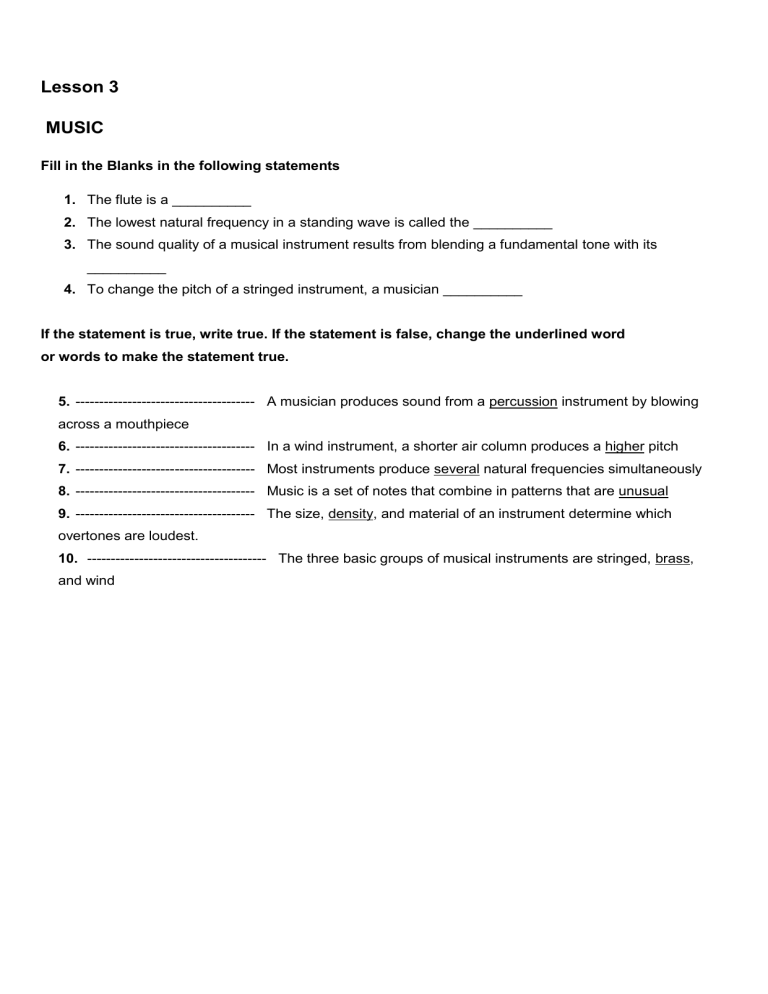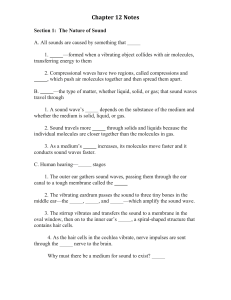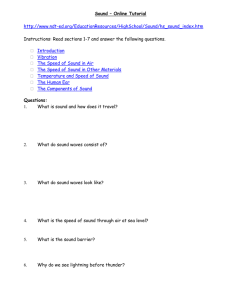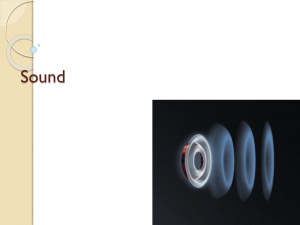Music & Sound Worksheet: Instruments, Properties, Hearing
advertisement

Lesson 3 MUSIC Fill in the Blanks in the following statements 1. The flute is a __________ 2. The lowest natural frequency in a standing wave is called the __________ 3. The sound quality of a musical instrument results from blending a fundamental tone with its __________ 4. To change the pitch of a stringed instrument, a musician __________ If the statement is true, write true. If the statement is false, change the underlined word or words to make the statement true. 5. -------------------------------------- A musician produces sound from a percussion instrument by blowing across a mouthpiece 6. -------------------------------------- In a wind instrument, a shorter air column produces a higher pitch 7. -------------------------------------- Most instruments produce several natural frequencies simultaneously 8. -------------------------------------- Music is a set of notes that combine in patterns that are unusual 9. -------------------------------------- The size, density, and material of an instrument determine which overtones are loudest. 10. -------------------------------------- The three basic groups of musical instruments are stringed, brass, and wind How are fundamental tones and overtones related? --------------------------------------------------------------------------------------What are the three basic groups of musical instruments? ------------------,--------------------------, What does the sound quality of musical instruments result from? ---------------------------------------------------------------------------------------------When does resonance occur? -------------------------------------------------------------- Why are acoustics used in the design of concert halls? ------------------------------------------------------------------How does resonance affect sound quality? ----------------------------------------------5. How do you control the loudness of an instrument? -----------------------------------------Match 1. Sound Quality ( ) A sound without pleasing patterns. 2. Overtone ( ) The lowest natural frequency of an object. 3. Music ( ) Whether a sound is pleasant or unpleasant 4. Noise ( 5. Fundamental Tone ( ) The object's higher frequencies. ) A pattern of notes that are pleasing. 1- Each instrument produces ___________ this accounts for the different sound qualities of instruments 2. -------------------------- An instrument that produces standing waves from a vibrating drum head 3. ------------------------- determines what note you hear 4. Fundamental tone is the ----------------------- natural frequency 5. ------------------------------- An instrument that produces standing waves by vibrating strings 6. A shorter air column produces a ______ 7. The size, shape, and material of an instrument determine the ____________;; 8. A longer air column produces a ____________;; 9. ____________ produce several natural frequencies at once 10. ____________ set of notes that combine in patterns that is pleasing to human ears 11. ____________ sounds that do not combine in pleasing patterns 12. ---------------- is the higher natural frequencies 13. ------------------------------------ These type of instruments vibrate when struck; to create louder sounds, a musician strikes it harder 14. ___________________________ results from blending a fundamental tone with its overtones 15. Standing waves can only occur at ________________ 16. Waves that travel on a string that is fixed at both ends; occur in all musical instruments are ____________;; 17. -----------------------These type of instruments produce sound when strings are plucked or bowed; to vary pitch, a musician changes the length of the vibrating string 18. To control ---------------- A musician changes the energy of the vibrations 19. To control ----------------- A musician changes the fundamental tones 20. -------------------------- An instrument that produces standing waves from a vibrating air column 21. --------------------------- These type of instruments create sound when a musician blows on the mouthpiece; this causes the air column on the inside to vibrate. Lesson 4 Hearing Sounds Fill in the Blanks 1. A(n) --------------- implant restores certain types of hearing loss. 2. Extended exposure to ------------ sounds can cause damage hair cells so that they can no longer send signals to the brain. 3. Hearing loss can occur if the -------------- is punctured. 4. Vibrations moving through the liquid of the --------------- causes messages to be sent through the auditory nerve 5. The hammer is attached to the -------------------------6. Aging is one cause of hearing ------------------------7. The outermost part of your ear looks like a ------------------------8. The three sections of the ear are the outer, middle and -----------------9. The three smallest bones in the ear - and in your body - are the hammer, anvil and -------------------10. Sound waves are converted to a signal that travels from your ear to your ----------------- 1. --------------- found in the middle ear; vibrations are transmitted from the hammer 2. ---------------- liquid-filled cavity shaped like a snail shell; contains 10,000 tiny structures called hair cells 3. What part of your body gathers sound waves and sends information about sound to your brain? ---------4. Region of the ear where sound waves are directed from the outer ear ---------------------------5. ---------------------- small, tightly stretched, drum-like membrane 6. ---------------- found in the middle ear; attached to the eardrum and vibrates 7. ---------------------- a device that can restore some ability to hear 8. ----------------------- converts sound waves into a form that travels to your brain 9. --------------- transmits the waves inward 10. ------------------- Funnels sound waves 11. One of the functions of your ear is to locate the direction of ---------------------------12. ---------------------- found in the middle ear; vibrations are transmitted from the anvil 1. -------------------- Is a liquid-filled cavity shaped like a snail shell. 2. .----------------------- A small, tightly stretched, drum-like membrane. 3. The hammer transmits vibrations to the ------------ then the -----------. 4. How many hair cells are found in a Cochlea? ------------------------------- 5. What are the parts of a hearing aid? -------------, -------------------, and ----------------------. 6. What is one cause of hearing damage? -------------------------------------------------------. 7. What is the use of a hearing aid? --------------------------------------------------------------------------------8. What is this part of the ear? 9. What is this part of the ear? 10. When the eardrum vibrates the ----------------------- does too. Lesson 2 Properties of Sounds Fill in the spaces 1- A 10-Db increase in loudness represents------------------------------------------------------------------------- 2- Loudness describes------------------------------------------------------------------------------------------------------ 3- When your vocal cords relax, you produce sound waves with ----------------------------------------------- 4- The waves infront of a moving sound source have----------------------------------------------------------------- Tell whether True or False 1- -------------------------------The DIFFUSION THEOREM explains a change that occurs in the frequency of a wave as its source moves in relation to an observer 2- -------------------------------The furthest apart a sound wave and its source are, the LESS energy the sound wave has in a given area 3- ------------------------------The LESS energy a sound wave has, the softer it sounds. 4- ------------------------------The loudness of different sounds is compared in units called HERTZ 5- ------------------------------A sound source vibrating with a large amplitude produces a sound wave with a SMALL amplitude. 6- -------------------------------Sounds louder than 60Db can cause damage to your ears 1- Loudness of different sounds is compared using a unit---------------------------- 2- The ---------------------------- occurs because the motion of the source causes the waves to either get closer together or spread out 3- The change in frequency of a wave as its source moves in relation to an observer is ----------------- 4- The more ---------------------------- a sound wave has, the louder it sounds. 5- The higher the amplitude of a sound wave, the higher the ---------------------------- 6- The ---------------------------- of a sound wave depends on how fast the source of a sound is vibrating. 7- SI unit for frequency is -------------------------- 8- A ----------------------------means there is a higher pitch 9- The amount of energy a sound wave carries per second through a unit area is ------------------- 10- A sound wave of greater ----------------------------sounds louder 11- A sound wave of lower ------------------------------- sounds softer 12- -------------------------------describes your awareness of the energy of a sound 13- ------------------------------ depends on the energy and intensity of a the sound wave 14- A -----------------------------means there is a lower pitch 15- The -------------------------of a sound you hear depends on the frequency of a sound wave 16- -------------------------------description of how high or how low sound seems to a person 17- Threshold of ------------------------- hearing is 0 dB What are the properties of sound? 1- ------------------------------- 3- ------------------------------- 2- ------------------------------- 4- ------------------------------- 1. The pitch of a sound that you hear depends on the sound wave’s a. frequency. b. loudness. c. intensity. d. Speed 2. The unit that measures the intensity of sound is called the a. Hertz. b. decibel. c. meters per second. d. watts per square meter. 3. What term refers to how high or low a sounds frequency is? a. Loudness b. Intensity c. Pitch d. Amplitude 4. What happens when sound waves strike the ear drum? a. Sound waves are absorbed by the eardrum. b. The walls of the outer ear change shape. c. Sound waves cause the eardrum to vibrate. d. The cochlea funnels the sound waves into the ear canal. 5. The most common type of hearing loss in teenagers is due to a. injury. b. infection or disease. c. aging. d. loud noise or music. 6. Which of the following statements is correct about the Doppler Effect? a. The effect is observed as waves bend around solid objects. b. It is observed as a change in pitch when either the sound source or the listener is in motion. c. It occurs as waves enter a new medium, such as going from water into air. d. It is the change in speed of a wave as the sound waves enter a medium and are reflected back. 7. The reason that a police car’s siren sounds HIGHER in pitch as it approaches you, is because the car pushes the sound waves together so that the sound wavelengths in front of the truck gets shorter. This causes the a. velocity to decrease which increases the frequency. b. frequency to increases, which increases the pitch. c. frequency to decrease which decreases the pitch. d. wavelengths to get longer, which increases the pitch.




